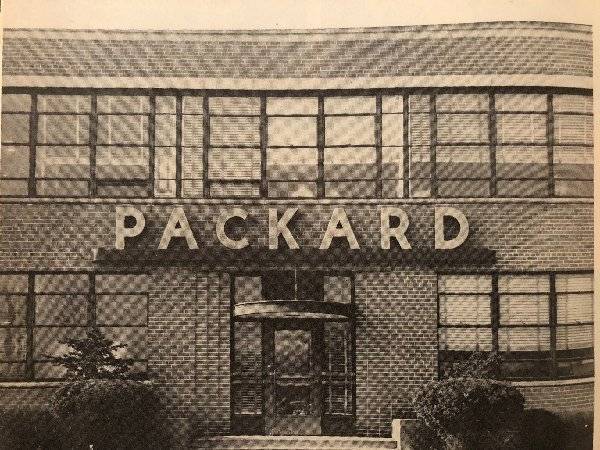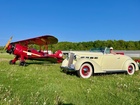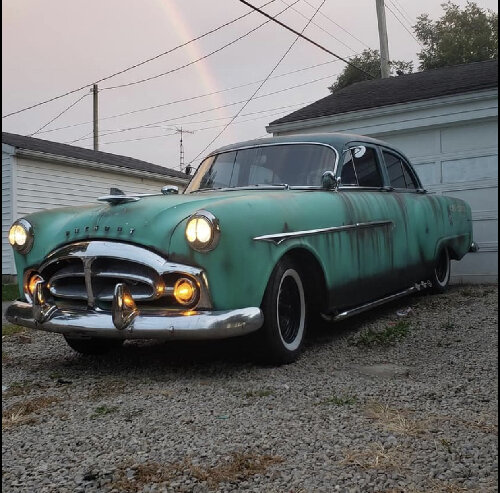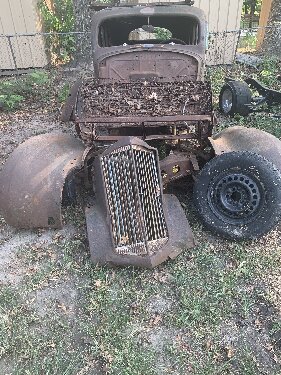|
Re: Caribbean convertable boot
|
||||
|---|---|---|---|---|
|
Home away from home

|
Quote:
Have a boot custom-made from a good original. Even if you were lucky enough to find an original, it would likely have shrunken. And keep two things in mind: ? A 1955 Caribbean boot is different from a 1956 boot. Don't try to use a 1956 boot as a pattern. ? Most original boots have shrunken over the years, so have your trimmer add just a bit to the new boot to allow for shrinkage and then double-check prior to adding the final snap-caps.
Posted on: 2018/11/24 12:26
|
|||
|
||||
|
Re: 56 concept
|
||||
|---|---|---|---|---|
|
Home away from home

|
Quote:
Ahhh... well. I should have known better than to say anything at all here in this raging furor over coulda-woulda-shoulda-mighta that is now going to be argued into the ground. But I'll say one absolute last thing: According to what I was told, Creative Industries did nothing at all to lengthen the rear door. It was a shaved Patrician rear door. I knew the guy who worked on it and he had no reason to lie about it despite whatever measurements can be approximated or calipered or whatever can be made from Photoshop in 2018. AND... the body used was a Four Hundred 2-door hardtop morphed into a pillarless 4-door. There was no "body insert." And for the record, what is shown here is just one of the incarnations of 4-door hardtops that were proposed. It is a proposal, not a final production piece. Who knows if any of it could have worked? There were others and while those photos are not around and available today, they existed. As did Patricians made on Clipper bodies (they made those too...and there are photos of these that exist). There was a lot done that people don't know about and can argue over today.... but not everybody doing the arguing actually saw this stuff. That is all I know. I've got no further comments on this subject.
Posted on: 2018/11/19 18:00
|
|||
|
||||
|
Re: 56 concept
|
||||
|---|---|---|---|---|
|
Home away from home

|
Quote:
As I recall, I was told that Creative Industries of Detroit did no lengthening whatsoever to the rear door. What they did was shave off the entire top of a Patrician rear door (all of the window frame assembly). Then, if you will notice, they went further... also shaved the vertical beltline surface and structure. Because this area no longer existed, it became necessary to place the door handles on a new lower position on the door. Of course, this was never finalized. Look closely and you'll see there is no place (no structure) to attach the handles in the usual positions. So any argument about this placement is moot. The idea here was to get a lower look to the car. Because this was basically a Four Hundred 2-door hardtop with four doors mooshed onto it there was an accentuation of the "high-pockets" look and a resulting stubbiness-both of which Dick Teague disliked. Look closely and you will note the roof has been somewhat altered. All four side windows would have been totally new pieces-made just for the 4-door hardtop only. But the 4-door hardtop would have looked even lower than the Four Hundred 2-door hardtop. Because of all this, the expense of making this car in production was simply not justified. So the 4-door hardtop would have to wait for 1957... but then we all know what happened to that plan.
Posted on: 2018/11/18 13:54
|
|||
|
||||
|
Re: Flexing wheels on 54 Cavalier
|
||||
|---|---|---|---|---|
|
Home away from home

|
Quote:
Radials... and the migrating wheel cover thing again. Ah-ahh-ahhh! You didn't try everything... As I have said numerous times before, it is a very, very simply matter to stop a wheelcover from working its way around the rim with radials installed. Go to a quality tire store... have them install metal valve stems. Done. End of story. I did this in the 1970s on my 1966 Cadillac Eldorado (this after TWO front bushing and suspension rebuild jobs). I assure you, the metal valve stems won't go anywhere-no matter what kind of wheelcover or tire you have installed. They cost a little more than the pop-in rubber stems... but they'll last the life of the automobile. No weird wheels or wheel cover removals needed.
Posted on: 2018/11/17 22:17
|
|||
|
||||
|
Re: Identify the year of the Packard Bus
|
||||
|---|---|---|---|---|
|
Home away from home

|
It appears the bus shown was Learmonth's Olds conversion, but this was followed by a Packard bus (converted from a Packard truck).
The idea to convert a Packard truck into a bus was likely derived from Earle C. Anthony of California-who was doing the same thing there around the same time. Mr. Anthony acquired two old stage lines, one of which was Pickwick Stage Lines. Mr. Anthony used his Packard buses all over routes in Southern California and established (and mapped-even before AAA) many roads and travel routes. He had one route that ran from Los Angeles to Bakersfield-quite a trip in the early 1900s prior to highways. Another route from L.A. ran through Riverside, California and parts beyond out into the desert. What did these Anthony-owned stage lines become? ALSO ancestors of Greyhound Bus Company. This information was presented in ECA's official bio information that was handed out to the press in the heyday of his KFI radio station in Los Angeles. Of course if helped that ECA also had the southwestern distributorship for Packard Motor Car Company. He was quite an entrepreneur and innovator.
Posted on: 2018/11/6 2:58
|
|||
|
||||
|
Re: Series 23 Stalling
|
||||
|---|---|---|---|---|
|
Home away from home

|
Every time I see these kinds of postings for postwar Packards I always think the same thing. Sometimes I even post the biggest cure I ever knew from back in the 1970s. But no one has ever commented that it helped. Anyway, I'll do it again.
Check the flex coupling in the fuel line where it leads to or from the fuel pump. What do you check for? Fine hairline cracks. You often have to remove the flex coupling and look at it very up close in good light. If you bend it and hairline cracks show up ... THAT is the problem. Used to see this all, all, all the time on postwar Packards-especially V-8s. It is not a visually obvious problem unless you do very close inspection. And it often does not make itself known with a leak. But it is the cause of many problems like this. The mechanic at Frost & French Packard dealership in Los Angeles decades ago told me people would bring cars in after buying a new fuel pump and would swear they sold them a bad pump... but the real problem the whole time was never the pump or the carb. It was the flex coupling in the fuel line. These couplings often look perfectly fine, but under pressure all kinds of things happen: they leak, they suck air, deform, etc. etc. It's a cheap fix, but almost no one ever tries it until they've already spent a pantload of money and wasted a lot of time. Anyway... for what it's worth...
Posted on: 2018/10/17 20:28
|
|||
|
||||
|
Re: How did the factory paint Carribeans in 1956
|
||||
|---|---|---|---|---|
|
Home away from home

|
Regarding signage at Conner Avenue??? Ask and ye shall receive...
This was the administration entrance. At night the metal letters were backlit. And as you can see here, there was more than one story to the building.
Posted on: 2018/9/24 0:35
|
|||
|
||||
|
Re: How did the factory paint Carribeans in 1956
|
||||
|---|---|---|---|---|
|
Home away from home

|
Quote:
randy berger wrote: You are most welcome. One of the guys my aunt worked for at Packard was responsible for setting up Conner. I interviewed him back in the 1970s and made a lot of notes-most of which I still have. One of the biggest heartbreaks of all looking back is that much of what went into Conner Avenue was new equipment. Even the signage outside, which was beautiful at night. It wasn't even there a full two years before it was shut down. A collossal loss. At first we used to drive past the idled plant and feel sorry about it. But when they started tearing it down my dad and I decided we didn't want to look at it being destroyed and we stopped taking that route down Conner Avenue. By the time we finally decided to go down Conner once again, all that remained was the end of a brick tower. It was a very, very sad time in Detroit. I am surprised today at how many people have forgotten this. I remember people putting their houses up for sale and moving (some out of state) immediately after... and it never stopped from that time on.
Posted on: 2018/9/22 9:09
|
|||
|
||||
|
Re: How did the factory paint Carribeans in 1956
|
||||
|---|---|---|---|---|
|
Home away from home

|
Quote:
If this is the same car that was pictured in another post with flaking paint, it was already apparent this car or the component shown was repainted and suffering from a case of lacquer crackle. Part of the reason for the lacquer crackle was two layers of paint repeatedly expanding and contracting at different rates. As for the Conner Plant painting the deck lids blue, this was certainly not a normal procedure for 1956 Caribbeans. Normally these cars were painted all Dover White (somewhere I have an image one one under construction prior to tri-toning) unless special-ordered with an unusual color scheme. Then stripe colors were added. And as I have said in a previous post long ago, Masking tape and paper were all one piece... and masking a Caribbean was a piece of cake for the pre-paint guys. Nothing at all to stress over. All the masking guy had to do was run the tape edge roughly down the middle of the trim attachment holes on the side of the body. There was still leeway even then. Remember, the stainless strips of trim that separated the colors were fairly wide. And here is where another myth can be exploded (though I'm certain it will continue anyway). ALL painting of 1955-56 bodies and components was done on the SECOND floor of the Conner Plant. Second floor... that's right. That same second floor that the myths tell you didn't exist. Normally bodies were painted red oxide primer. They were usually assembled with doors and deck lid in place and all this in primer. The primer was baked to harden it. The front fenders and hood were painted separately (usually in black primer, then Dover White top coat). There were other stages in these paint applications, but painting a deck lid blue on a Caribbean just wasn't normal procedure. By the way, paint colors were applied based on information that was telegraphed to the plant. So... this said, it was a possibility for a mistake to be made... a TWX to be mis-read. And folks need to understand something here. With a total of 276 Caribbean convertibles and 263 hardtops for 1956... please. We're not looking at a tough goal here. When I worked on the first Mustangs we sometimes turned out 800 cars on a single shift! Anyway... for what it's worth...
Posted on: 2018/9/21 0:09
|
|||
|
||||

 (528.14 KB)
(528.14 KB)







